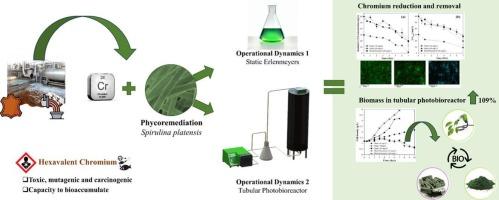Advanced photobioreactor strategy for chromium phycoremediation with Spirulina platensis
Q1 Environmental Science
引用次数: 0
Abstract
The study investigates the phycoremediation of Cr(VI) by Spirulina platensis under static cultivation (batch system) and a tubular photobioreactor. An inoculum of Spirulina platensis (1.2 g L−1) was exposed to 30 and 60 mg L−1 Cr(VI). Cellular resistance was verified until day seven, after which chromium exposure led to cell growth inhibition and reduced chlorophyll production. Chromium removal was verified through two mechanisms: initial passive biosorption on cell walls, facilitated by functional groups identified via Fourier-transform infrared spectroscopy, followed by active intracellular bioaccumulation, where Cr(VI) was reduced to less toxic Cr(III) via enzymatic activity. Scanning electron microscopy and energy-dispersive X-ray spectroscopy confirmed the adsorption of chromium on the cell surface. In the static system, final biomass reached 0.65 g L−1 (46 % reduction), while the photobioreactor produced 3.19 g L−1 (18.2 % below control). Total chromium removal efficiencies reached 69.3 % (10 days) and 67.1 % (7 days) in static and photobioreactor systems, respectively.

螺旋藻藻修复铬的先进光生物反应器策略
在静态培养(间歇式)和管式光生物反应器条件下,研究了螺旋藻对铬(VI)的藻修复作用。将接种的螺旋藻(1.2 g L - 1)暴露于30和60 mg L - 1 Cr(VI)中。直到第7天,细胞抗性才得到证实,之后铬暴露导致细胞生长抑制和叶绿素产生减少。铬的去除通过两种机制得到验证:最初在细胞壁上的被动生物吸附,通过傅里叶变换红外光谱识别的官能团促进,然后是细胞内的主动生物积累,其中Cr(VI)通过酶活性还原为毒性较小的Cr(III)。扫描电镜和能量色散x射线光谱证实了铬在细胞表面的吸附。在静态系统中,最终生物量达到0.65 g L−1(减少46%),而光生物反应器产生3.19 g L−1(比控制低18.2%)。在静态和光生物反应器系统中,总铬去除率分别达到69.3%(10天)和67.1%(7天)。
本文章由计算机程序翻译,如有差异,请以英文原文为准。
求助全文
约1分钟内获得全文
求助全文
来源期刊

Bioresource Technology Reports
Environmental Science-Environmental Engineering
CiteScore
7.20
自引率
0.00%
发文量
390
审稿时长
28 days
 求助内容:
求助内容: 应助结果提醒方式:
应助结果提醒方式:


